Fibromyalgia, Pain, and Physical Activity: A Bibliometric Analysis
Abstract
1. Introduction
2. Materials and Methods
2.1. Design and Data Source
2.2. Statistical Analysis
3. Results
3.1. Annual Publication Trends
3.2. Web of Science Categories
3.3. Publication Titles
3.4. Most Prolific Co-Author
3.5. Countries/Regions
3.6. Most Cited Documents
3.7. Author Keywords
4. Discussion
5. Conclusions
Author Contributions
Funding
Institutional Review Board Statement
Informed Consent Statement
Data Availability Statement
Acknowledgments
Conflicts of Interest
Appendix A
| WOS:000334306000022; | WOS:000392426900002; | WOS:000225070100028; |
| WOS:000254121100020; | WOS:000231194600002; | WOS:000259774100017; |
| WOS:000184239300011; | WOS:A1994NG01600026; | WOS:000181712100010; |
| WOS:000257602000015; | WOS:000086106000010; | WOS:000280227900024; |
| WOS:A1996UH09000004; | WOS:000263246400010; | WOS:000274481800003; |
| WOS:000250188700158; | WOS:000189245600007; | WOS:000223975100003; |
| WOS:000256503900032; | WOS:000089669300028; | WOS:000294470000007; |
| WOS:A1996UP53900019; | WOS:000286192000022; | WOS:000257602000007; |
| WOS:000233281800023; | WOS:000270691200032; | WOS:000079617700007; |
| WOS:000247116600033; | WOS:000281733300015; | WOS:000318907100033; |
| WOS:000226507700038; | WOS:000177243900015; | WOS:000182639000031; |
| WOS:000220764600006; | WOS:000188896400016; | WOS:000329188500042; |
| WOS:000250806200005; | WOS:000282826100038; | WOS:000171814800006; |
| WOS:A1992JF19400005; | WOS:000173317400004; | WOS:000283657300022; |
| WOS:000175430100030; | WOS:000289557100023; | WOS:000297712700007; |
| WOS:A1992HX73300011; | WOS:000236800400012; | WOS:A1992JA28300012; |
| WOS:000227270300008; | WOS:000224096900005; | WOS:000326483600017; |
| WOS:000372544500005; | WOS:000236800400013; | WOS:A1994NP65400003; |
| WOS:000300594200011; | WOS:000234216000006; | WOS:000075858700010; |
| WOS:000240985200002; | WOS:000322387300002; | WOS:A1996WM82400004; |
| WOS:000283185300004; | WOS:000320758700004; | WOS:000178625200011; |
| WOS:000252503400005; | WOS:000254206100004; | WOS:A1994PC52100010; |
| WOS:000347646000084; | WOS:000227976900022; | WOS:000177349900010; |
| WOS:000297350300001; | WOS:000184239300008; | WOS:000174214100028; |
| WOS:000184262700013; | WOS:000247823800003; | WOS:000222039400007; |
| WOS:000239339400007; | WOS:000263204300002; | WOS:000408840400040; |
| WOS:000255598800002; | WOS:000165597800033; | WOS:000174214100029; |
References
- Clauw, D.J. Fibromyalgia: A Clinical Review. JAMA 2014, 311, 1547–1555. [Google Scholar] [CrossRef] [PubMed]
- Cabo-Meseguer, A.; Cerdá-Olmedo, G.; Trillo-Mata, J.L. Fibromialgia: Prevalencia, Perfiles Epidemiológicos y Costes Económicos. Med. Clin. 2017, 149, 441–448. [Google Scholar] [CrossRef] [PubMed]
- Sumpton, J.E.; Moulin, D.E. Fibromyalgia: Presentation and Management with a Focus on Pharmacological Treatment. Pain Res. Manag. 2008, 13, 477–483. [Google Scholar] [CrossRef] [PubMed]
- Hartzell, M.M.; Neblett, R.; Perez, Y.; Brede, E.; Mayer, T.G.; Gatchel, R.J. Do Comorbid Fibromyalgia Diagnoses Change after a Functional Restoration Program in Patients with Chronic Disabling Occupational Musculoskeletal Disorders? Spine 2014, 39, 1393–1400. [Google Scholar] [CrossRef]
- Wang, C.; McAlindon, T.; Fielding, R.A.; Harvey, W.F.; Driban, J.B.; Price, L.L.; Kalish, R.; Schmid, A.; Scott, T.M.; Schmid, C.H. A Novel Comparative Effectiveness Study of Tai Chi versus Aerobic Exercise for Fibromyalgia: Study Protocol for a Randomized Controlled Trial. Trials 2015, 16, 34. [Google Scholar] [CrossRef]
- Collado-Mateo, D.; Olivares, P.R.; Adsuar, J.C.; Gusi, N. Impact of Fibromyalgia on Sexual Function in Women. J. Back Musculoskelet. Rehabil. 2020, 33, 355–361. [Google Scholar] [CrossRef]
- Tavares, L.F.; Germano Maciel, D.; Pereira Barros da Silva, T.Y.; Brito Vieira, W.H. de Comparison of Functional and Isokinetic Performance between Healthy Women and Women with Fibromyalgia. J. Bodyw. Mov. Ther. 2020, 24, 248–252. [Google Scholar] [CrossRef]
- Cerón-Lorente, L.; Valenza, M.C.; Pérez-Mármol, J.M.; del Carmen García-Ríos, M.; Castro-Sánchez, A.M.; Aguilar-Ferrándiz, M.E. The Influence of Balance, Physical Disability, Strength, Mechanosensitivity and Spinal Mobility on Physical Activity at Home, Work and Leisure Time in Women with Fibromyalgia. Clin. Biomech. 2018, 60, 157–163. [Google Scholar] [CrossRef]
- Walker, J. Fibromyalgia: Clinical Features, Diagnosis and Management. Nurs. Stand. R. Coll. Nurs. G. B. 1987 2016, 31, 51–63. [Google Scholar] [CrossRef]
- Alvarez, M.C.; Albuquerque, M.L.L.; Neiva, H.P.; Cid, L.; Rodrigues, F.; Teixeira, D.S.; Matos, R.; Antunes, R.; Morales-Sánchez, V.; Monteiro, D. Exploring the Relationship between Fibromyalgia-Related Fatigue, Physical Activity, and Quality of Life. Int. J. Environ. Res. Public. Health 2022, 19, 4870. [Google Scholar] [CrossRef]
- Macfarlane, G.J.; Kronisch, C.; Dean, L.E.; Atzeni, F.; Häuser, W.; Flub, E.; Choy, E.; Kosek, E.; Amris, K.; Branco, J.; et al. EULAR Revised Recommendations for the Management of Fibromyalgia. Ann. Rheum. Dis. 2017, 76, 318–328. [Google Scholar] [CrossRef]
- Huijnen, I.P.J.; Verbunt, J.A.; Meeus, M.; Smeets, R.J.E.M. Energy Expenditure during Functional Daily Life Performances in Patients with Fibromyalgia. Pain Pract. 2015, 15, 748–756. [Google Scholar] [CrossRef] [PubMed]
- Masquelier, E.; D’haeyere, J. Physical Activity in the Treatment of Fibromyalgia. Jt. Bone Spine 2021, 88, 105202. [Google Scholar] [CrossRef] [PubMed]
- Ursini, F.; Naty, S.; Grembiale, R.D. Fibromyalgia and Obesity: The Hidden Link. Rheumatol. Int. 2011, 31, 1403–1408. [Google Scholar] [CrossRef] [PubMed]
- Chinn, S.; Caldwell, W.; Gritsenko, K. Fibromyalgia Pathogenesis and Treatment Options Update. Curr. Pain Headache Rep. 2016, 20, 25. [Google Scholar] [CrossRef] [PubMed]
- Arnold, L.M.; Hudson, J.I.; Hess, E.V.; Ware, A.E.; Fritz, D.A.; Auchenbach, M.B.; Starck, L.O.; Keck, P.E. Family Study of Fibromyalgia. Arthritis Rheum. 2004, 50, 944–952. [Google Scholar] [CrossRef]
- Choy, E.H. Current Treatments to Counter Sleep Dysfunction as a Pathogenic Stimulus of Fibromyalgia. Pain Manag. 2016, 6, 339–346. [Google Scholar] [CrossRef]
- Gerdle, B.; Leinhard, O.D.; Lund, E.; Bengtsson, A.; Lundberg, P.; Ghafouri, B.; Forsgren, M.F. Fibromyalgia: Associations Between Fat Infiltration, Physical Capacity, and Clinical Variables. J. Pain Res. 2022, 15, 2517–2535. [Google Scholar] [CrossRef]
- Megía García, Á.; Serrano-Muñoz, D.; Bravo-Esteban, E.; Ando Lafuente, S.; Avendaño-Coy, J.; Gómez-Soriano, J. Efectos Analgésicos de La Estimulación Eléctrica Nerviosa Transcutánea En Pacientes Con Fibromialgia: Una Revisión Sistemática. Aten. Primaria 2019, 51, 406. [Google Scholar] [CrossRef]
- Siracusa, R.; Di Paola, R.; Cuzzocrea, S.; Impellizzeri, D. Fibromyalgia: Pathogenesis, Mechanisms, Diagnosis and Treatment Options Update. Int. J. Mol. Sci. 2021, 22, 3891. [Google Scholar] [CrossRef]
- Kundakci, B.; Kaur, J.; Goh, S.L.; Hall, M.; Doherty, M.; Zhang, W.; Abhishek, A. Efficacy of Nonpharmacological Interventions for Individual Features of Fibromyalgia: A Systematic Review and Meta-Analysis of Randomised Controlled Trials. Pain 2022, 163, 1432–1445. [Google Scholar] [CrossRef] [PubMed]
- Couto, N.; Monteiro, D.; Cid, L.; Bento, T. Effect of Different Types of Exercise in Adult Subjects with Fibromyalgia: A Systematic Review and Meta-Analysis of Randomised Clinical Trials. Sci. Rep. 2022, 12, 10391. [Google Scholar] [CrossRef] [PubMed]
- Fink, L.; Lewis, D. Exercise as a Treatment for Fibromyalgia: A Scoping Review. J. Nurse Pract. 2017, 13, 546–551.e2. [Google Scholar] [CrossRef]
- de Almeida Silva, H.J.; Júnior, J.C.A.; de Oliveira, F.S.; de Pontes Oliveira, J.M.; Dantas, G.A.F.; de Almeida Lins, C.A.; de Souza, M.C. Sophrology versus Resistance Training for Treatment of Women with Fibromyalgia: A Randomized Controlled Trial. J. Bodyw. Mov. Ther. 2019, 23, 382–389. [Google Scholar] [CrossRef] [PubMed]
- Genc, A.; Tur, B.S.; Aytur, Y.K.; Oztuna, D.; Erdogan, M.F. Does Aerobic Exercise Affect the Hypothalamic-Pituitary-Adrenal Hormonal Response in Patients with Fibromyalgia Syndrome? J. Phys. Ther. Sci. 2015, 27, 2225–2231. [Google Scholar] [CrossRef] [PubMed]
- Espí-López, G.V.; Inglés, M.; Ruescas-Nicolau, M.A.; Moreno-Segura, N. Effect of Low-Impact Aerobic Exercise Combined with Music Therapy on Patients with Fibromyalgia. A Pilot Study. Complement. Ther. Med. 2016, 28, 1–7. [Google Scholar] [CrossRef]
- Vural, M.; Berkol, T.D.; Erdogdu, Z.; Pekedis, K.; Kuçukserat, B.; Aksoy, C. Evaluation of the Effectiveness of an Aerobic Exercise Program and the Personality Characteristics of Patients with Fibromyalgia Syndrome: A Pilot Study. J. Phys. Ther. Sci. 2014, 26, 1561–1565. [Google Scholar] [CrossRef]
- Palstam, A.; Larsson, A.; Löfgren, M.; Ernberg, M.; Bjersing, J.; Bileviciute-Ljungar, I.; Gerdle, B.; Kosek, E.; Mannerkorpi, K. Decrease of Fear Avoidance Beliefs Following Person-Centered Progressive Resistance Exercise Contributes to Reduced Pain Disability in Women with Fibromyalgia: Secondary Exploratory Analyses from a Randomized Controlled Trial. Arthritis Res. Ther. 2016, 18, 116. [Google Scholar] [CrossRef]
- Shigematsu, R.; Okura, T.; Sakai, T.; Rantanen, T. Square-Stepping Exercise versus Strength and Balance Training for Fall Risk Factors. Aging Clin. Exp. Res. 2008, 20, 19–24. [Google Scholar] [CrossRef]
- Antunes, M.D.; Couto, L.A.; Bertolini, S.M.M.G.; da Rocha Loures, F.C.N.; Schmitt, A.C.B.; Marques, A.P. Effectiveness of Interdisciplinary Health Education Programs for Individuals with Fibromyalgia: A Systematic Review. J. Educ. Health Promot. 2021, 10, 64. [Google Scholar] [CrossRef]
- Garcia-Palacios, A.; Herrero, R.; Vizcaíno, Y.; Belmonte, M.A.; Castilla, D.; Molinari, G.; Banõs, R.M.; Botella, C. Integrating Virtual Reality with Activity Management for the Treatment of Fibromyalgia: Acceptability and Preliminary Efficacy. Clin. J. Pain 2015, 31, 564–572. [Google Scholar] [CrossRef] [PubMed]
- Collado-Mateo, D.; Dominguez-Muñoz, F.J.; Adsuar, J.C.; Merellano-Navarro, E.; Gusi, N. Exergames for Women with Fibromyalgia: A Randomised Controlled Trial to Evaluate the Effects on Mobility Skills, Balance and Fear of Falling. PeerJ 2017, 2017, e3211. [Google Scholar] [CrossRef] [PubMed]
- López-Pousa, S.; Bassets Pagès, G.; Monserrat-Vila, S.; De Gracia Blanco, M.; Hidalgo Colomé, J.; Garre-Olmo, J. Sense of Well-Being in Patients with Fibromyalgia: Aerobic Exercise Program in a Mature Forest—A Pilot Study. Evid. Based Complement. Alternat. Med. 2015, 2015, 614783. [Google Scholar] [CrossRef] [PubMed]
- García-Ríos, M.C.; Navarro-Ledesma, S.; Tapia-Haro, R.M.; Toledano-Moreno, S.; Casas-Barragán, A.; Correa-Rodríguez, M.; Aguilar-Ferrándiz, M.E. Effectiveness of Health Education in Patients with Fibromyalgia: A Systematic Review. Eur. J. Phys. Rehabil. Med. 2019, 55, 301–313. [Google Scholar] [CrossRef] [PubMed]
- Mendoza-Muñoz, M.; Morenas-Martín, J.; Rodal, M.; García-Matador, J.; García-Gordillo, M.Á.; Calzada-Rodríguez, J.I. Knowledge about Fibromyalgia in Fibromyalgia Patients and Its Relation to HRQoL and Physical Activity. Biology 2021, 10, 673. [Google Scholar] [CrossRef]
- Acuña Ortiz, F.E.; Capitán de la Cruz, V.A.; León Jiménez, F.E. Knowledge on Fibromyalgia Among General Practitioners, From Chiclayo-Peru, 2016. Reumatol. Clín. Engl. Ed. 2017, 13, 326–330. [Google Scholar] [CrossRef]
- Menten, L.A.; Franco, K.F.M.; Franco, Y.R.S.; Miyamoto, G.C.; Reis, F.J.J.; Cabral, C.M.N. Do Patients with Fibromyalgia Have Body Image and Tactile Acuity Distortion? Pain Pract. 2022, 22, 678–687. [Google Scholar] [CrossRef]
- Ceballos-Laita, L.; Mingo-Gómez, M.T.; Estébanez-De-miguel, E.; Bueno-Gracia, E.; Navas-Cámara, F.J.; Verde-Rello, Z.; Fernández-Araque, A.; Jiménez-Del-barrio, S. Does the Addition of Pain Neurophysiology Education to a Therapeutic Exercise Program Improve Physical Function in Women with Fibromyalgia Syndrome? Secondary Analysis of a Randomized Controlled Trial. J. Clin. Med. 2021, 10, 2518. [Google Scholar] [CrossRef]
- Matias, M.G.L.; Germano Maciel, D.; França, I.M.; Cerqueira, M.S.; Silva, T.C.L.A.; Okano, A.H.; Pegado, R.; Brito Vieira, W.H. Transcranial Direct Current Stimulation Associated With Functional Exercise Program for Treating Fibromyalgia: A Randomized Controlled Trial. Arch. Phys. Med. Rehabil. 2022, 103, 245–254. [Google Scholar] [CrossRef]
- Häuser, W.; Thieme, K.; Turk, D.C. Guidelines on the Management of Fibromyalgia Syndrome—A Systematic Review. Eur. J. Pain 2010, 14, 5–10. [Google Scholar] [CrossRef]
- Üçeyler, N.; Burgmer, M.; Friedel, E.; Greiner, W.; Petzke, F.; Sarholz, M.; Schiltenwolf, M.; Winkelmann, A.; Sommer, C.; Häuser, W. Etiology and Pathophysiology of Fibromyalgia Syndrome: Updated Guidelines 2017, Overview of Systematic Review Articles and Overview of Studies on Small Fiber Neuropathy in FMS Subgroups. Schmerz 2017, 31, 239–245. [Google Scholar] [CrossRef] [PubMed]
- Bidonde, J.; Boden, C.; Busch, A.J.; Goes, S.M.; Kim, S.; Knight, E. Dance for Adults With Fibromyalgia—What Do We Know About It? Protocol for a Scoping Review. JMIR Res. Protoc. 2017, 6, e6873. [Google Scholar] [CrossRef] [PubMed]
- Ortega-Martín, M.E.; Gamero-Lucas, J.J.; López-Sánchez, J.A. Análisis Bibliométrico de La Evolución Temática En Fibromialgia y Biomecánica (1985–2021). Rehabilitación 2022, 56, 226–236. [Google Scholar] [CrossRef] [PubMed]
- Merayo Alonso, L.A.; Cano García, F.J.; Rodríguez Franco, L.; Ariza Ariza, R.; Navarro Sarabia, F. A Bibliometric Approach to Research Into Fibromyalgia. Reumatol. Clín. Engl. Ed. 2007, 3, 55–62. [Google Scholar] [CrossRef]
- Vittori, A.; Cascella, M.; Leonardi, M.; Monaco, F.; Nocerino, D.; Cuomo, A.; Ottaiano, A.; Perri, F.; Mascilini, I.; Francia, E.; et al. VOSviewer-Based Bibliometric Network Analysis for Evaluating Research on Juvenile Primary Fibromyalgia Syndrome (JPFS). Children 2022, 9, 637. [Google Scholar] [CrossRef]
- Li, P.; Zheng, H.; Chen, Y.; Liu, Z.; He, J. Knowledge Mapping of Acupuncture for Fibromyalgia from 1990 to 2022: A Bibliometric Analysis. J. Pain Res. 2022, 15, 2405–2426. [Google Scholar] [CrossRef]
- Bağcier, F.; İNal Yorulmaz, E.; Çağlar Yağci, H. Top 100 Cited Articles on Fibromyalgia Syndrome: A Bibliometric and Altmetric Analyses Study. Agri 2021, 33, 53–63. [Google Scholar] [CrossRef]
- José de Oliveira, O.; Francisco da Silva, F.; Juliani, F.; César Ferreira Motta Barbosa, L.; Vieira Nunhes, T. Bibliometric Method for Mapping the State-of-the-Art and Identifying Research Gaps and Trends in Literature: An Essential Instrument to Support the Development of Scientific Projects. In Scientometrics Recent Advances; Kunosic, S., Zerem, E., Eds.; IntechOpen: London, UK, 2019; ISBN 978-1-78984-712-3. [Google Scholar]
- Contreras-Barraza, N.; Madrid-Casaca, H.; Salazar-Sepúlveda, G.; Garcia-Gordillo, M.Á.; Adsuar, J.C.; Vega-Muñoz, A. Bibliometric Analysis of Studies on Coffee/Caffeine and Sport. Nutrients 2021, 13, 3234. [Google Scholar] [CrossRef]
- Hernández-Torrano, D.; Ho, Y.S. A Bibliometric Analysis of Publications in the Web of Science Category of Educational Psychology in the Last Two Decades. Psicol. Educ. Rev. Psicólogos Educ. 2021, 27, 101–113. [Google Scholar] [CrossRef]
- Price, D.D.S. A General Theory of Bibliometric and Other Cumulative Advantage Processes. J. Am. Soc. Inf. Sci. 1976, 27, 292–306. [Google Scholar] [CrossRef]
- Dobrov, G.M.; Randolph, R.H.; Rauch, W.D. New Options for Team Research via International Computer Networks. Scientometrics 1979, 1, 387–404. [Google Scholar] [CrossRef]
- Desai, N.; Veras, L.; Gosain, A. Using Bradford’s Law of Scattering to Identify the Core Journals of Pediatric Surgery. J. Surg. Res. 2018, 229, 90–95. [Google Scholar] [CrossRef] [PubMed]
- Morse, P.M.; Leimkuhler, F.F. Technical Note—Exact Solution for the Bradford Distribution and Its Use in Modeling Informational Data. Oper. Res. 1979, 27, 187–198. [Google Scholar] [CrossRef]
- Hirsch, J.E. An Index to Quantify an Individual’s Scientific Research Output. Proc. Natl. Acad. Sci. USA 2005, 102, 16569–16572. [Google Scholar] [CrossRef] [PubMed]
- Crespo, N.; Simoes, N. Publication Performance Through the Lens of the H-Index: How Can We Solve the Problem of the Ties? Soc. Sci. Q. 2019, 100, 2495–2506. [Google Scholar] [CrossRef]
- Valderrama-Zurián, J.C.; García-Zorita, C.; Marugán-Lázaro, S.; Sanz-Casado, E. Comparison of MeSH Terms and KeyWords Plus Terms for More Accurate Classification in Medical Research Fields. A Case Study in Cannabis Research. Inf. Process. Manag. 2021, 58, 102658. [Google Scholar] [CrossRef]
- Greenfield, S.; Fitzcharles, M.-A.; Esdaile, J.M. Reactive Fibromyalgia Syndrome. Arthritis Rheum. 1992, 35, 678–681. [Google Scholar] [CrossRef]
- Henriksson, C.; Gundmark, I.; Bengtsson, A.; Ek, A.C. Living with Fibromyalgia. Consequences for Everyday Life. Clin. J. Pain 1992, 8, 138–144. [Google Scholar] [CrossRef]
- Carville, S.F.; Arendt-Nielsen, S.; Bliddal, H.; Blotman, F.; Branco, J.C.; Buskila, D.; Da Silva, J.A.P.; Danneskiold-Samsøe, B.; Dincer, F.; Henriksson, C.; et al. EULAR Evidence-Based Recommendations for the Management of Fibromyalgia Syndrome. Ann. Rheum. Dis. 2008, 67, 536–541. [Google Scholar] [CrossRef]
- Nichols, D.S.; Glenn, T.M. Effects of Aerobic Exercise on Pain Perception, Affect, and Level of Disability in Individuals With Fibromyalgia. Phys. Ther. 1994, 74, 327–332. [Google Scholar] [CrossRef]
- Nijs, J.; Van Houdenhove, B. From Acute Musculoskeletal Pain to Chronic Widespread Pain and Fibromyalgia: Application of Pain Neurophysiology in Manual Therapy Practice. Man. Ther. 2009, 14, 3–12. [Google Scholar] [CrossRef] [PubMed]
- Staud, R.; Cannon, R.C.; Mauderli, A.P.; Robinson, M.E.; Price, D.D.; Vierck, C.J. Temporal Summation of Pain from Mechanical Stimulation of Muscle Tissue in Normal Controls and Subjects with Fibromyalgia Syndrome. Pain 2003, 102, 87–95. [Google Scholar] [CrossRef] [PubMed]
- Goldenberg, D.L.; Burckhardt, C.; Crofford, L. Management of Fibromyalgia Syndrome. JAMA 2004, 292, 2388–2395. [Google Scholar] [CrossRef] [PubMed]
- McLoughlin, M.J.; Colbert, L.H.; Stegner, A.J.; Cook, D.B. Are Women with Fibromyalgia Less Physically Active than Healthy Women? Med. Sci. Sports Exerc. 2011, 43, 905. [Google Scholar] [CrossRef] [PubMed]
- Tomas-Carus, P.; Häkkinen, A.; Gusi, N.; Leal, A.; Häkkinen, K.; Ortega-Alonso, A. Aquatic Training and Detraining on Fitness and Quality of Life in Fibromyalgia. Med. Sci. Sports Exerc. 2007, 39, 1044–1050. [Google Scholar] [CrossRef]
- Mease, P. Fibromyalgia Syndrome: Review of Clinical Presentation, Pathogenesis, Outcome Measures, and Treatment. J. Rheumatol. Suppl. 2005, 75, 6–21. [Google Scholar]
- Arnold, L.M.; Crofford, L.J.; Mease, P.J.; Burgess, S.M.; Palmer, S.C.; Abetz, L.; Martin, S.A. Patient Perspectives on the Impact of Fibromyalgia. Patient Educ. Couns. 2008, 73, 114–120. [Google Scholar] [CrossRef]
- Ambrose, K.R.; Golightly, Y.M. Physical Exercise as Non-Pharmacological Treatment of Chronic Pain: Why and When. Best Pract. Res. Clin. Rheumatol. 2015, 29, 120–130. [Google Scholar] [CrossRef]
- Le Fur Bonnabesse, A.; Cabon, M.; L’Heveder, G.; Kermarrec, A.; Quinio, B.; Woda, A.; Marchand, S.; Dubois, A.; Giroux-Metges, M.A.; Rannou, F.; et al. Impact of a Specific Training Programme on the Neuromodulation of Pain in Female Patient with Fibromyalgia (DouFiSport): A 24-Month, Controlled, Randomised, Double-Blind Protocol. BMJ Open 2019, 9, e023742. [Google Scholar] [CrossRef]
- Schmidt, S.; Grossman, P.; Schwarzer, B.; Jena, S.; Naumann, J.; Walach, H. Treating Fibromyalgia with Mindfulness-Based Stress Reduction: Results from a 3-Armed Randomized Controlled Trial. Pain 2011, 152, 361–369. [Google Scholar] [CrossRef]
- Muñoz Ladrón de Guevara, C.; Reyes Del Paso, G.A.; Fernández Serrano, M.J.; Montoro, C.I. Fibromyalgia Syndrome and Cognitive Decline: The Role of Body Mass Index and Clinical Symptoms. J. Clin. Med. 2022, 11, 3404. [Google Scholar] [CrossRef] [PubMed]
- Gulsen, C.; Soke, F.; Eldemir, K.; Apaydin, Y.; Ozkul, C.; Guclu-Gunduz, A.; Akcali, D.T. Effect of Fully Immersive Virtual Reality Treatment Combined with Exercise in Fibromyalgia Patients: A Randomized Controlled Trial. Assist. Technol. 2020, 1–8. [Google Scholar] [CrossRef] [PubMed]
- Navarro-Ledesma, S.; Gonzalez-Muñoz, A.; Carroll, J.; Burton, P. Short- and Long-Term Effects of Whole-Body Photobiomodulation on Pain, Functionality, Tissue Quality, Central Sensitisation and Psychological Factors in a Population Suffering from Fibromyalgia: Protocol for a Triple-Blinded Randomised Clinical Trial. Ther. Adv. Chronic Dis. 2022, 13, 20406223221078095. [Google Scholar] [CrossRef] [PubMed]
- Albuquerque, M.L.L.; Monteiro, D.; Marinho, D.A.; Vilarino, G.T.; Andrade, A.; Neiva, H.P. Effects of Different Protocols of Physical Exercise on Fibromyalgia Syndrome Treatment: Systematic Review and Meta-Analysis of Randomized Controlled Trials. Rheumatol. Int. 2022, 42, 1893–1908. [Google Scholar] [CrossRef] [PubMed]
- Galvão-Moreira, L.V.; de Castro, L.O.; Moura, E.C.R.; de Oliveira, C.M.B.; Nogueira Neto, J.; Gomes, L.M.R.D.S.; Leal, P.D.C. Pool-Based Exercise for Amelioration of Pain in Adults with Fibromyalgia Syndrome: A Systematic Review and Meta-Analysis. Mod. Rheumatol. 2021, 31, 904–911. [Google Scholar] [CrossRef]
- Newcomb, L.W.; Koltyn, K.F.; Morgan, W.P.; Cook, D.B. Influence of Preferred versus Prescribed Exercise on Pain in Fibromyalgia. Med. Sci. Sports Exerc. 2011, 43, 1106–1113. [Google Scholar] [CrossRef]
- Rebutini, V.Z.; Giaretta, M.T.; Da Silva, J.R.; Da Silva Mayork, A.K.; Abad, C.C.C. Efeito Do Treinamento Resistido Em Paciente Com Fibromialgia: Estudo de Caso. Mot. Rev. Educ. Física 2013, 19, 513–522. [Google Scholar] [CrossRef]
- Pérez-De la Cruz, S.; Lambeck, J. Effects of a Programme of Aquatic Ai Chi Exercise in Patients with Fibromyalgia. A Pilot Study. Rev. Neurol. 2015, 60, 59–65. [Google Scholar] [CrossRef]
- Lazaridou, A.; Koulouris, A.; Devine, J.K.; Haack, M.; Jamison, R.N.; Edwards, R.R.; Schreiber, K.L. Impact of Daily Yoga-Based Exercise on Pain, Catastrophizing, and Sleep amongst Individuals with Fibromyalgia. J. Pain Res. 2019, 12, 2915–2923. [Google Scholar] [CrossRef]
- Ide, M.R.; Laurindo, L.M.M.; Rodrigues-Júnior, A.L.; Tanaka, C. Effect of Aquatic Respiratory Exercise-Based Program in Patients with Fibromyalgia. Int. J. Rheum. Dis. 2008, 11, 131–140. [Google Scholar] [CrossRef]
- Ang, D.C.; Kaleth, A.S.; Bigatti, S.; Mazzuca, S.; Saha, C.; Hilligoss, J.; Lengerich, M.; Bandy, R. Research to Encourage Exercise for Fibromyalgia (REEF): Use of Motivational Interviewing Design and Method. Contemp. Clin. Trials 2011, 32, 59–68. [Google Scholar] [CrossRef] [PubMed]
- Ayán Pérez, C.; Álvarez, M.J.; Alonso-Cortés, B.; Barrientos, M.J.; Valencia, M.; Martín, V. Health Education Home-Based Program in Females with Fibromyalgia: A Pilot Study. J. Back Musculoskelet. Rehabil. 2009, 22, 99–105. [Google Scholar] [CrossRef] [PubMed]
- Dobkin, P.L.; Da Costa, D.; Abrahamowicz, M.; Dritsa, M.; Du Berger, R.; Fitzcharles, M.A.; Lowensteyn, I. Adherence during an Individualized Home Based 12-Week Exercise Program in Women with Fibromyalgia. Available online: https://www.cochranelibrary.com/content?templateType=related&urlTitle=/central/doi/10.1002/central/CN-00555044&doi=10.1002/central/CN-00555044&p_p_id=scolariscontentdisplay_WAR_scolariscontentdisplay&_scolariscontentdisplay_WAR_scolariscontentdisplay_acti (accessed on 28 October 2022).
- Murillo-García, Á.; Villafaina, S.; Adsuar, J.C.; Gusi, N.; Collado-Mateo, D. Effects of Dance on Pain in Patients with Fibromyalgia: A Systematic Review and Meta-Analysis. Evid. Based Complement. Alternat. Med. 2018, 2018, 8709748. [Google Scholar] [CrossRef] [PubMed]
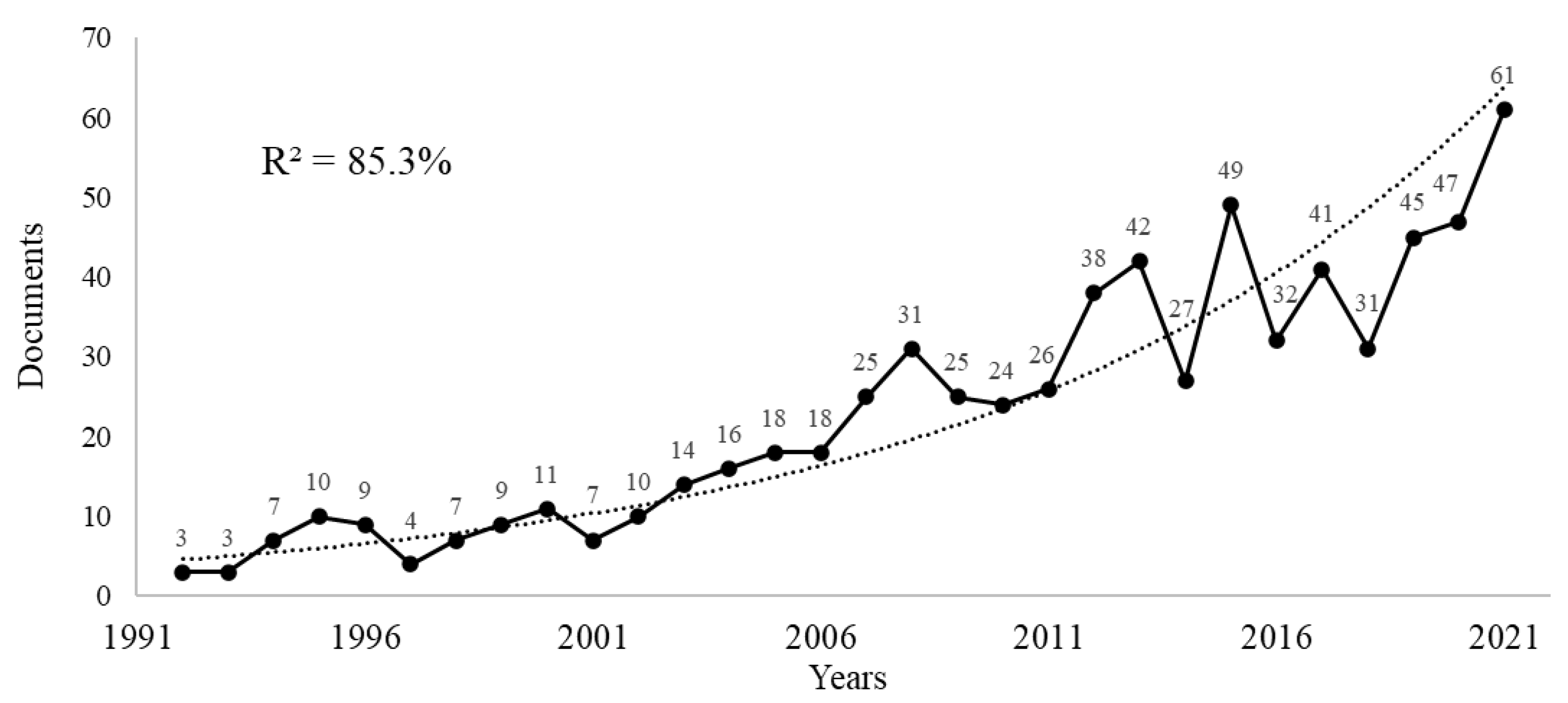
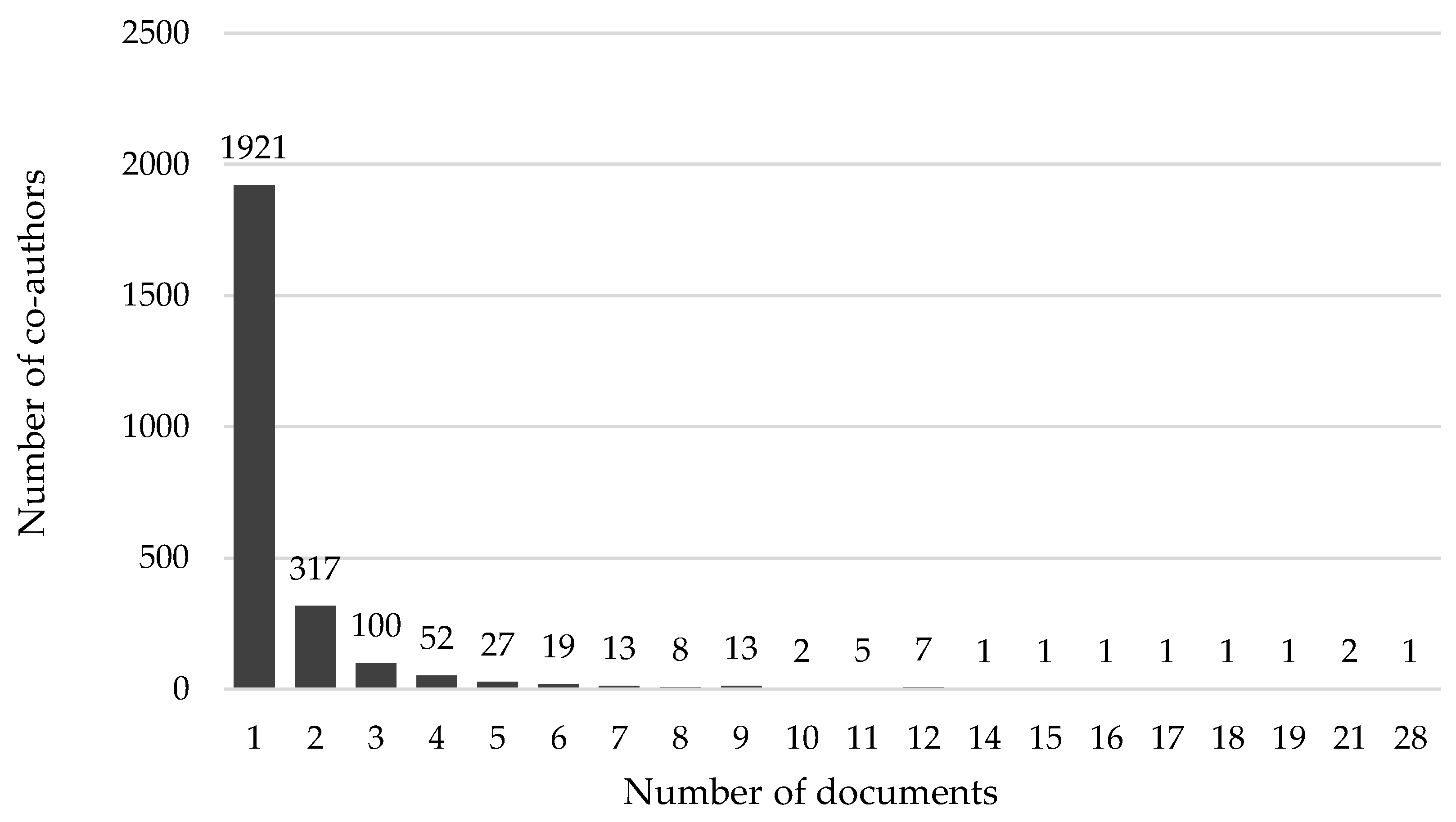
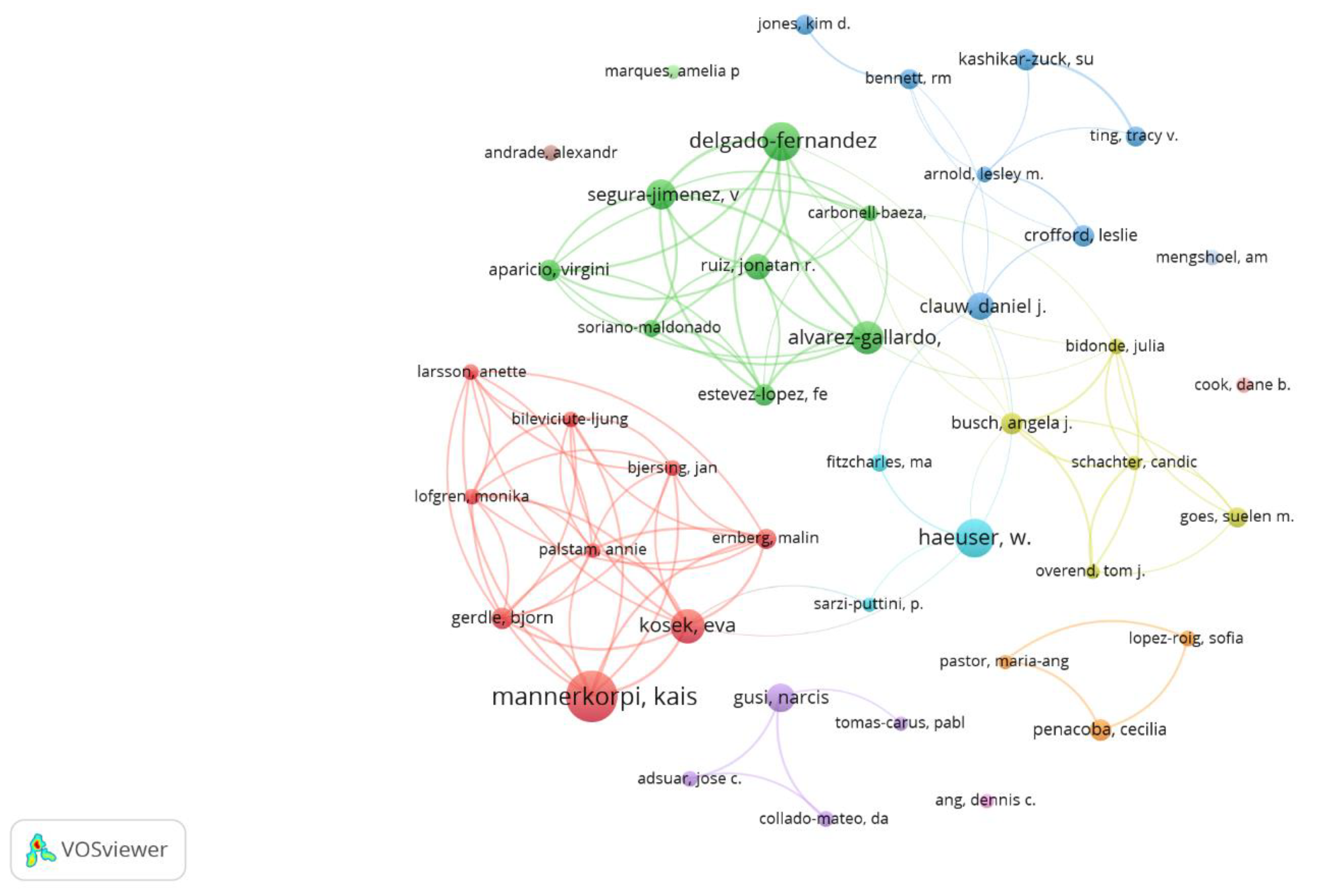

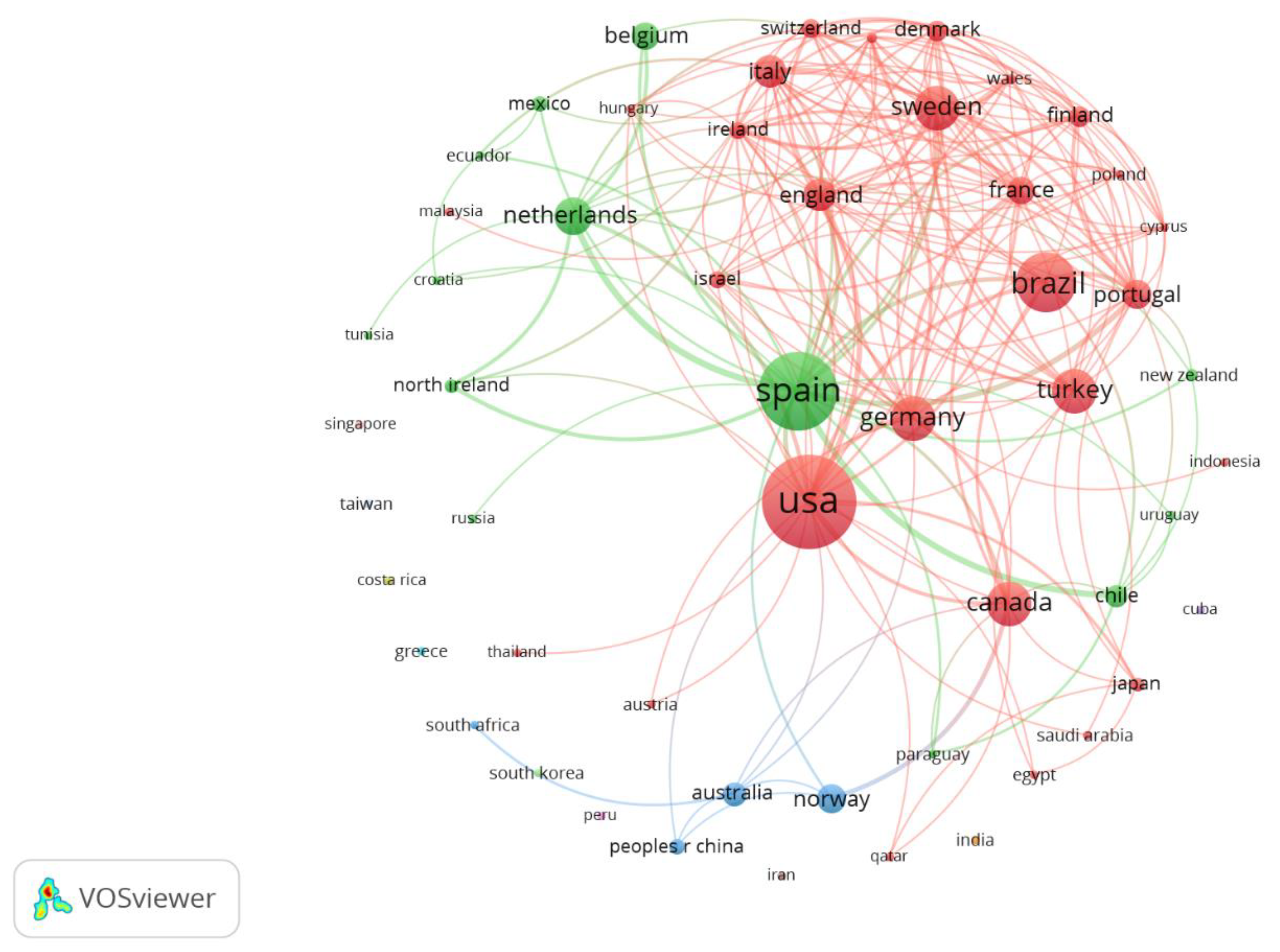
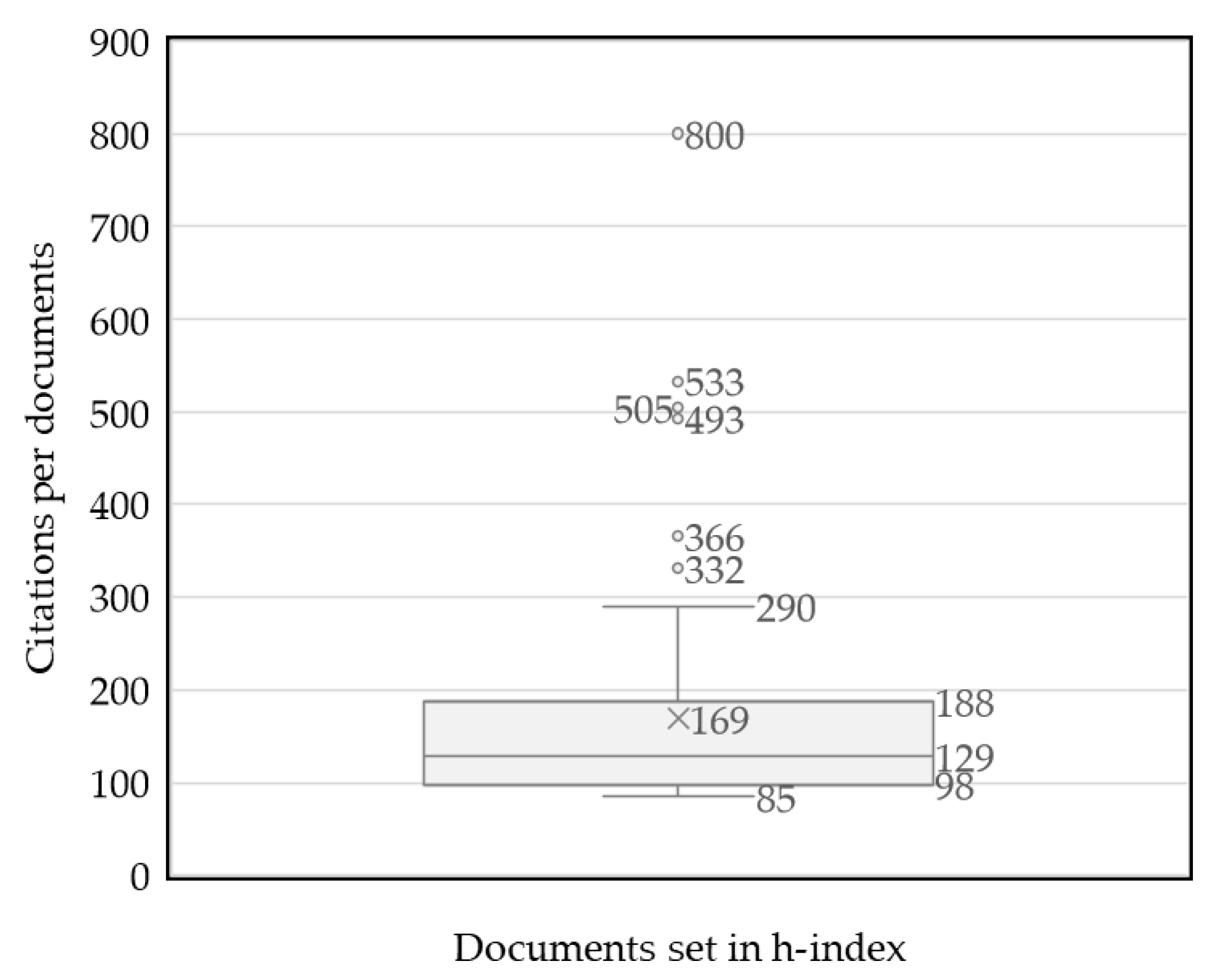
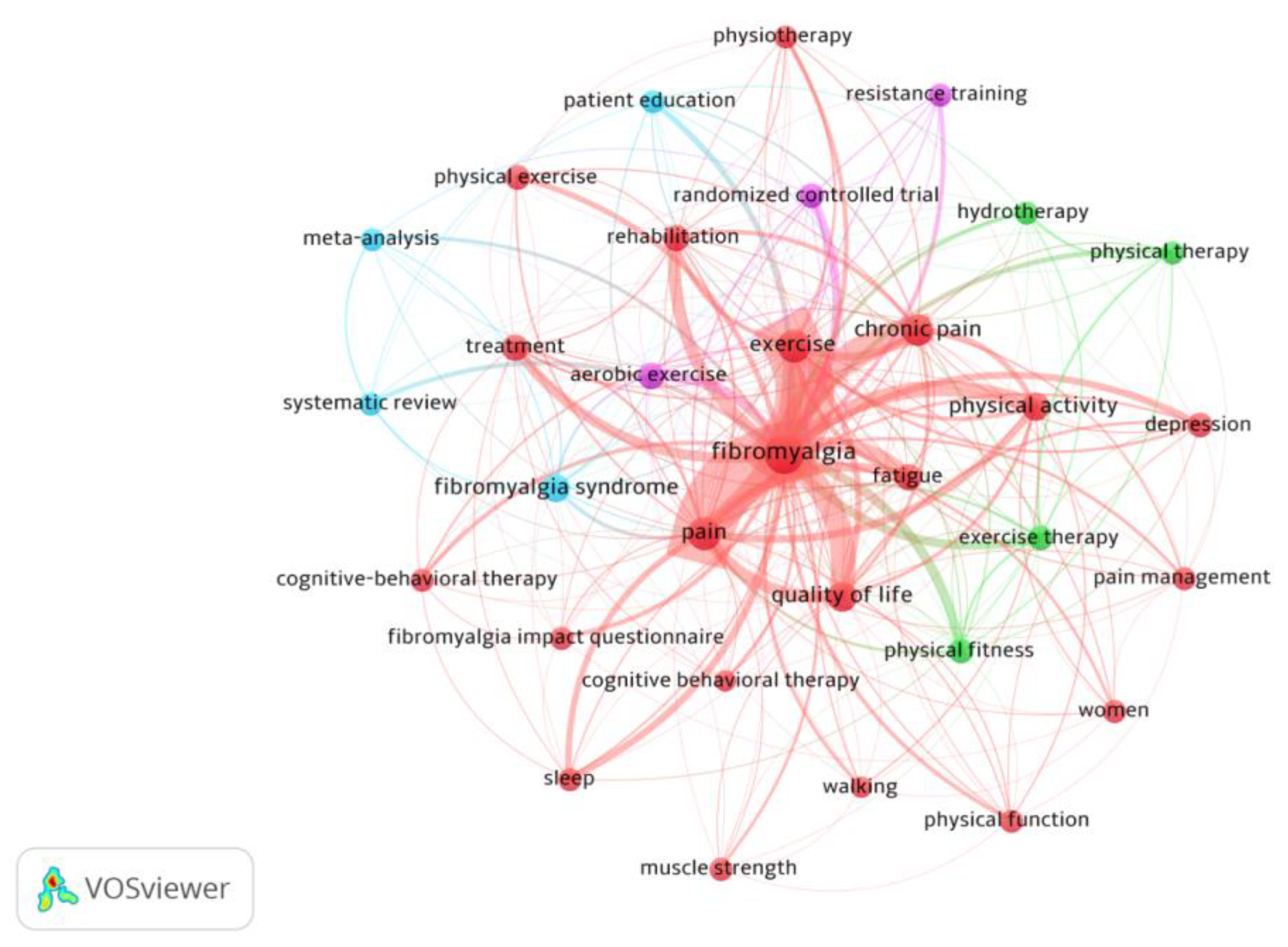
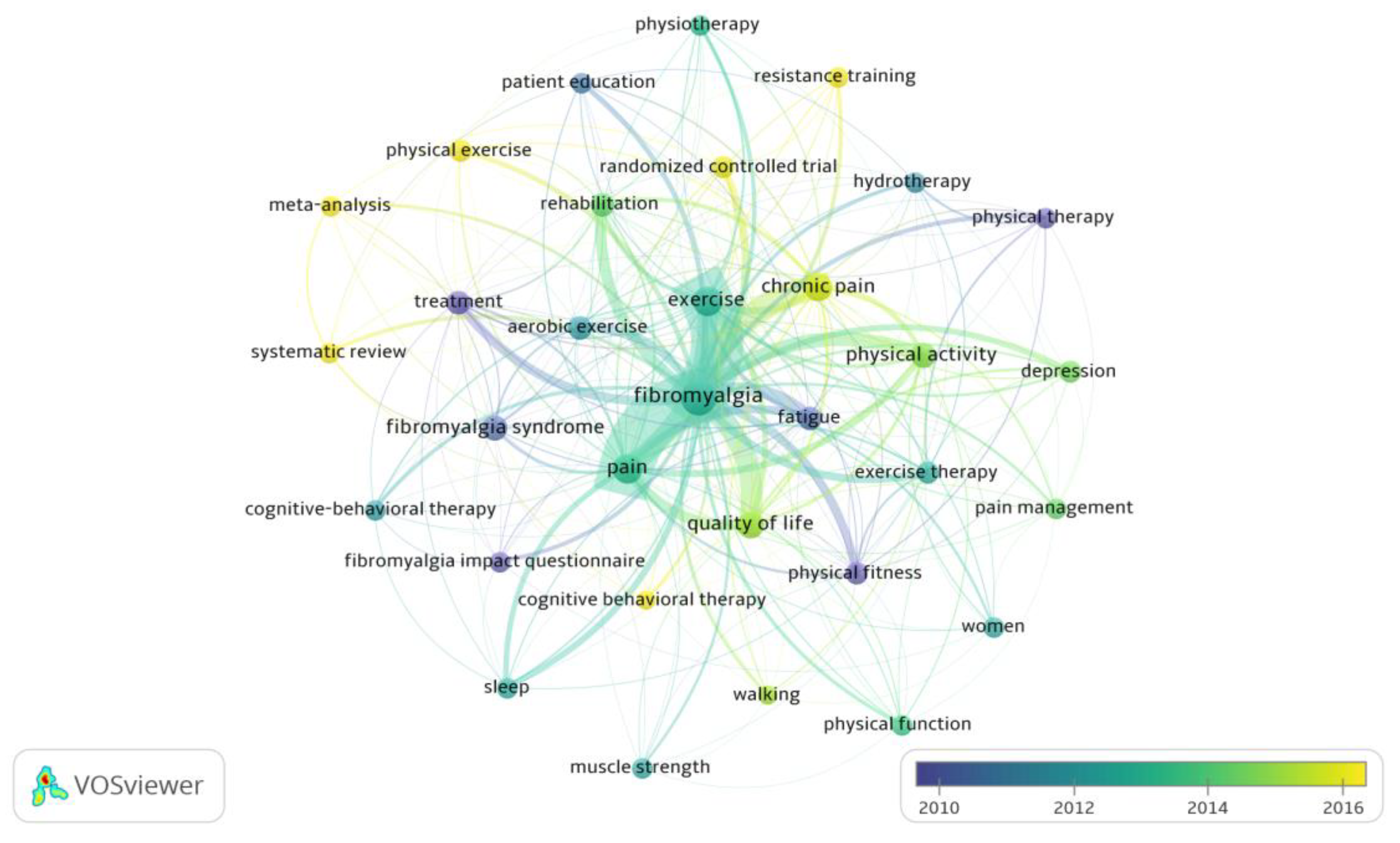
| Bradford’s Zone | Journals (Publisher) | N° Doc. | %Doc. | Cit. | JIF | Q. | %O.A. |
|---|---|---|---|---|---|---|---|
| Core | Rheumatology International (Springer) | 30 | 4.1 | 915 | 3.580 | Q3 | 18.1 |
| Clinical & Experimental Rheumatology (Clinical & Experimental Rheumatology S.A.S.) | 24 | 3.3 | 905 | 4.862 | Q2 | 0 | |
| Journal of Rheumatology (The Journal of Rheumatology Publishing Co. Ltd.) | 23 | 3.1 | 2469 | 5.346 | Q2 | 1 | |
| Journal of Musculoskeletal Pain (Taylor & Francis) | 21 | 2.8 | 198 | n.a. | n.a. | n.a. | |
| Arthritis Care & Research (Wiley) | 15 | 2 | 548 | 5.178 | Q2 | 13.5 | |
| Clinical Rheumatology (Springer) | 15 | 2 | 445 | 3.650 | Q3 | 10.8 | |
| Pain (Lippincott Williams & Wilkins) | 15 | 2 | 1557 | 7.926 | Q1 | 16.8 | |
| Archives of Physical Medicine and Rehabilitation (Elsevier) | 12 | 1.6 | 395 | 4.060 | Q1 | 6.2 | |
| Clinical Journal of Pain (Lippincott Williams & Wilkins) | 12 | 1.6 | 741 | 3.423 | Q2 | 9.3 | |
| International Journal of Environmental Research and Public Health (MDPI) | 12 | 1.6 | 50 | 4.614 | Q1 | 95 | |
| Journal of Back and Musculoskeletal Rehabilitation (IOS Press) | 12 | 1.6 | 66 | 1.456 | Q4 | 1.1 | |
| Arthritis & Rheumatism-Arthritis Care & Research (Wiley) | 11 | 1.5 | 1428 | n.a. | n.a. | n.a. | |
| Arthritis Research & Therapy (BMC) | 10 | 1.4 | 732 | 5.607 | Q1 | 100 | |
| Journal of Pain (Churchill Livingstone) | 10 | 1.4 | 551 | 5.383 | Q1 | 9.4 | |
| Schmerz (Springer) | 10 | 1.4 | 261 | 1.629 | Q4 | 19.1 |
| Bradford’s Zone | Journals (Publishers) | N° Doc. | Cit. | %Cit. | JIF | Q. | %O.A. |
|---|---|---|---|---|---|---|---|
| Core | Journal of Rheumatology (The Journal of Rheumatology Publishing Co. Ltd.) | 23 | 2469 | 9.4 | 5.346 | Q2 | 1 |
| Pain (Lippincott Williams & Wilkins) | 15 | 1557 | 5.9 | 7.926 | Q1 | 16 | |
| Arthritis & Rheumatism-arthritis Care & Research (Wiley) | 11 | 1428 | 5.5 | n.a. | n.a. | n.a. | |
| Annals of the Rheumatic Diseases (BMJ) | 4 | 1323 | 5.1 | 27.973 | Q1 | 38.7 | |
| Jama (Journal of the American Medical Association) | 2 | 1305 | 5 | 157.335 | Q1 | 1.5 | |
| Rheumatology International (Springer) | 30 | 915 | 3.5 | 3.580 | Q3 | 18.1 | |
| Zone I | Clinical & Experimental Rheumatology (Clinical & Experimental Rheumatology S.A.S.) | 24 | 905 | 3.5 | 4.862 | Q2 | 0 |
| Cochrane Database of Systematic Reviews (Wiley) | 9 | 755 | 2.9 | 12.008 | Q1 | 0.1 | |
| Clinical Journal of Pain (Lippincott Williams & Wilkins) | 12 | 741 | 2.8 | 3.423 | Q2 | 9.3 | |
| Arthritis Research & Therapy (BMC) | 10 | 732 | 2.8 | 5.607 | Q1 | 100 | |
| Arthritis and Rheumatism (Wiley) | 8 | 645 | 2.5 | n.a. | n.a. | n.a. | |
| Journal of Pain (Churchill Livingstone) | 10 | 551 | 2.1 | 5.383 | Q1 | 9.4 | |
| Arthritis Care & Research (Wiley) | 15 | 548 | 2.1 | 5.178 | Q2 | 13.5 | |
| European Journal of Pain (Wiley) | 8 | 542 | 2.1 | 3.651 | Q2 | 27.3 | |
| Best Practice & Research in Clinical Rheumatology (Elsevier) | 4 | 518 | 2. | 4.991 | Q2 | 5.8 | |
| Clinical Rheumatology (Springer) | 15 | 445 | 1.7 | 3.650 | Q3 | 10.8 | |
| Scandinavian Journal of Rheumatology (Taylor & Francis) | 6 | 430 | 1.6 | 3.057 | Q3 | 23.8 | |
| Archives of Physical Medicine and Rehabilitation (Elsevier) | 12 | 395 | 1.5 | 4.060 | Q1 | 6.2 | |
| Current Pain and Headache Reports (Springer) | 4 | 385 | 1.5 | 3.904 | Q2 | 2.9 | |
| Medicine and Science in Sports and Exercise (Lippincott Williams & Wilkins) | 6 | 373 | 1.4 | 5.411 | Q1 | 7 | |
| Patient Education and Counseling (Elsevier) | 2 | 351 | 1.3 | 3.467 | Q1 | 13.5 | |
| Rheumatology (Oxford Univ Press) | 5 | 314 | 1.2 | 7.046 | Q1 | 25.9 |
Disclaimer/Publisher’s Note: The statements, opinions and data contained in all publications are solely those of the individual author(s) and contributor(s) and not of MDPI and/or the editor(s). MDPI and/or the editor(s) disclaim responsibility for any injury to people or property resulting from any ideas, methods, instructions or products referred to in the content. |
© 2023 by the authors. Licensee MDPI, Basel, Switzerland. This article is an open access article distributed under the terms and conditions of the Creative Commons Attribution (CC BY) license (https://creativecommons.org/licenses/by/4.0/).
Share and Cite
Denche-Zamorano, Á.; Barrios-Fernandez, S.; Mendoza-Muñoz, M.; Carlos-Vivas, J.; Vega-Muñoz, A.; Collado-Mateo, D.; Olivares, P.R.; Adsuar, J.C. Fibromyalgia, Pain, and Physical Activity: A Bibliometric Analysis. Int. J. Environ. Res. Public Health 2023, 20, 1335. https://doi.org/10.3390/ijerph20021335
Denche-Zamorano Á, Barrios-Fernandez S, Mendoza-Muñoz M, Carlos-Vivas J, Vega-Muñoz A, Collado-Mateo D, Olivares PR, Adsuar JC. Fibromyalgia, Pain, and Physical Activity: A Bibliometric Analysis. International Journal of Environmental Research and Public Health. 2023; 20(2):1335. https://doi.org/10.3390/ijerph20021335
Chicago/Turabian StyleDenche-Zamorano, Ángel, Sabina Barrios-Fernandez, María Mendoza-Muñoz, Jorge Carlos-Vivas, Alejandro Vega-Muñoz, Daniel Collado-Mateo, Pedro R. Olivares, and José Carmelo Adsuar. 2023. "Fibromyalgia, Pain, and Physical Activity: A Bibliometric Analysis" International Journal of Environmental Research and Public Health 20, no. 2: 1335. https://doi.org/10.3390/ijerph20021335
APA StyleDenche-Zamorano, Á., Barrios-Fernandez, S., Mendoza-Muñoz, M., Carlos-Vivas, J., Vega-Muñoz, A., Collado-Mateo, D., Olivares, P. R., & Adsuar, J. C. (2023). Fibromyalgia, Pain, and Physical Activity: A Bibliometric Analysis. International Journal of Environmental Research and Public Health, 20(2), 1335. https://doi.org/10.3390/ijerph20021335













